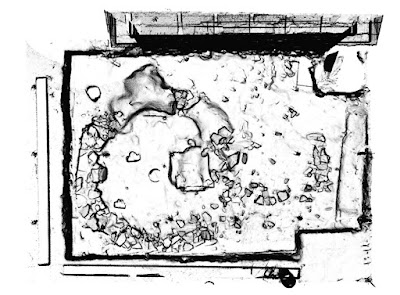During
the early nineteenth century, conflict between England and France led to an
American trade embargo that restricted the importation of goods from these
countries. Soon after, English hostilities on the high seas that led to the War
of 1812 also stopped the flow of foreign goods to America, including fine
British ceramics. The lack of certain imported goods led to the establishment
of a number of new American industrial enterprises to fill the void.
In
the late 1700s and early 1800s, a form of thin, cream-colored ceramic called
creamware was being manufactured in England. One style of creamware was made
popular by British Queen Charlotte and became known as Queensware. Queensware
enjoyed immense commercial popularity and was one of the items banned during
the embargo and subsequent war.
Creamware Cup (left)
Shown with a Copy in American Queensware (right)
Utilizing
local clays, some possibly dug from within the city, Philadelphia potters
attempted to make their own versions of Queensware and other fine British
earthenware ceramics. However, the use of local clays produced a more yellow
vessel body rather than white or cream colored. Some potteries, such as the
newly-formed Columbian Pottery, offered a British-trained potter to make the
enterprise seem more authentic. By 1808, Scottish-born Master Potter Alexander
Trotter was producing earthen tablewares for the Columbian, including yellow
tea and coffee pots, sugar boxes, jugs, baking dishes, chamber pots, and other
items. The Columbian’s goods were advertised “at prices much lower than they
can be imported” and at rates that “are less than half the price of the
cheapest imported Liverpool Queensware” (Myers 1980).
AMERICAN
Manufactured
Queensware, at the following reasonable
rates-viz
Chamber
Pots 4s a $2 25 per doz
Ditto
ditto 6s 1
80 ditto
Wash
Hand Basons 4s 2
ditto
Ditto
ditto 6s 1
60 ditto
Pitchers 4s 2
70 ditto
Coffee
Pots 4s 5 ditto
Ditto
ditto 6s 4 ditto
Tea Pots 12s 2 25 ditto
Ditto 18s 1 80 ditto
Pitchers 6s 1 80 ditto
Dinner
Plates 75 cents per dozen-all other sizes, with every other article of
Queensware, in proportion
Copied from a Price
List for Columbian Pottery Wares in Relfs
Philadelphia Gazette and Daily Advertiser 1813
Philadelphia Queensware
Pitcher and Teapot from PHMC Collections
Trotter’s
wares became popular and were soon advertised for sale as far away as
Alexandria, Virginia and other cities along the east coast. Trotter continued
his work in Philadelphia until around 1815, when the Columbian Pottery closed
up and he moved to Pittsburgh. For a short time period Trotter continued
manufacturing Queensware in the Pittsburgh area, where he produced vessel forms
that were “similar to those of the Potteries in Philadelphia” (Myers 1980).
By
1810, another Scotsman, Captain John Mullowny, was advertising similar ceramic
articles for sale at his Washington Pottery on Market Street. Mullowny also
appears to have been successful in his ventures and by 1812 he had added specialized
production techniques and included engine-turned and press-molded Queensware
vessels in his inventory (Myers 1980). An advertisement from that same year
lists the many vessel forms produced by the Washington Pottery (Philadelphia Aurora General Advertiser
1812).
WAREHOUSE
OF THE
WASHINGTON
POTTERY,
HIGH NEAR SCHUYLKILL SIXTH
STREET,
The public are informed that
Soup and Shallow
PLATES are now ready for delivery in addition to the
following articles, of which a constant supply is always
kept up.
CUPS & SAUCERS,
SUGARS & CREAMS,
Gallon, Quart, Pint & Half Pint Grelled & Plain PITCHERS
Gallon, Quart, Pint and Half Pint BOWLS,
SALT and PEPPER BOXES,
STEWING DISHES that will stand the fire,
BASINS and EWERS,
WINE COOLERS,
MANTLE ORNAMENTS & GARDEN POTS
Quart, Pint and Half Pint MUGS,
GOBLETS, TUMBLERS & EGG CUPS,
BUTTER TUBS & BUTTER BOATS,
PICKLING JARS & JELLY POTS of all sizes,
MILK PANS, &c, &c, &c.
The Plates manufactured at the
Washington Pottery,
will be found by experience superior to imported plates,
when necessary to stew on a chafing dish or embers, as
they will stand the heat without cracking.
1812
Ad Copied from a Philadelphia Aurora
General Advertiser for the Washington Pottery
Following
the end of the war in 1815, many of the potteries continued to manufacture Queensware
vessels; however, the resumption of trade with Britain meant that the finer
quality Staffordshire wares were available once again and at rates similar to
the American-made knock-offs. Ceramics, as well as other British goods, flooded
the market in 1815 and 1816 in an attempt to stifle the new American industries.
Soon it became apparent that the Philadelphia potters could not compete with
England’s finer pieces and most of the Queensware producers were out of
business by 1820.
The
State Museum collections house a number of examples of Queensware recovered from
archaeological sites located mainly in the city of Philadelphia. Evaluation of
these pieces indicates that the quality of the Philadelphia wares is somewhat
lacking. Many issues related to the Queensware pieces appear to be associated
with the production and firing of the vessels including: overfired, burned, or
bubbled glaze; kiln furniture marks; uneven or missing glaze; crazing; smeared
clay; and pitting. Every piece identified as Queensware exhibited at least one,
if not several, of these flaws.
Closeup of Queensware
Cup Showing Cracking and Missing Glaze (Center Top) and Speckling
If
you found this blog of interest and would like more detailed information,
articles regarding Queensware will be published in an upcoming issue of The Journal for Northeast Historical
Archaeology. Additional information on Philadelphia ceramics and citations
for this blog can be found in the following sources:
Miller,
George L. and Amy C. Earls
2008 War and Pots: The Impact of Economics and
Politics on Ceramic Consumption Patterns. In Ceramics in America 2008.
Myers,
Susan H.
1980 Handcraft
to Industry: Philadelphia Ceramics in the First Half of the Nineteenth Century.
Smithsonian Studies in History and Technology, No. 43. Washington: Smithsonian
Institution Press.
Philadelphia Aurora General Advertiser
1812 October 27.
Relfs Philadelphia Gazette and Daily Advertiser
1813 April.







